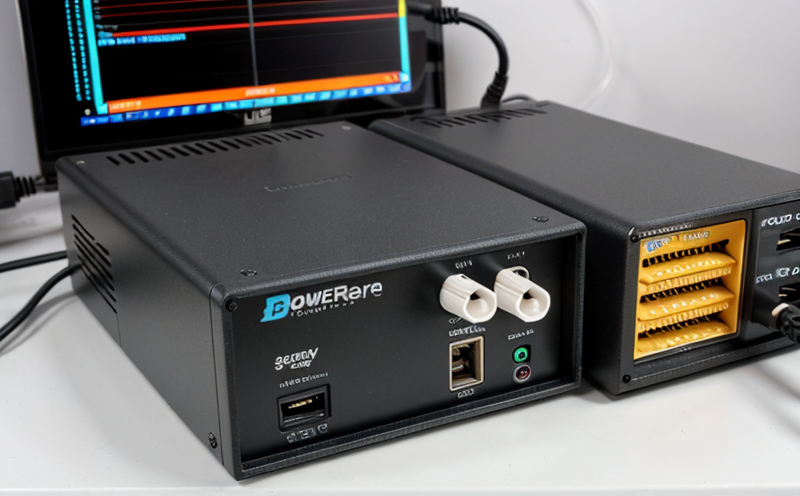IEC 61000 3 2 Harmonics Testing for Power Supply Units
The IEC (International Electrotechnical Commission) 61000-3-2 standard is a critical guideline for ensuring that electronic devices, particularly power supply units, meet stringent requirements regarding harmonic distortion. Harmonics can distort the waveform of electrical signals and impact the performance of other connected equipment within a facility or power distribution network.
Harmonic distortion occurs when non-harmonic currents are introduced into an AC power system. These harmonics can originate from various sources such as switching devices, rectifiers, inverters, and nonlinear loads in general. For power supply units (PSUs), ensuring compliance with IEC 61000-3-2 is essential to mitigate these issues.
The standard defines the limits for both current and voltage harmonics up to the 51st harmonic. It also specifies measurement methods and acceptance criteria to ensure that equipment does not introduce excessive harmonic distortion into a power distribution network. This testing is crucial in ensuring that PSUs operate efficiently and do not cause interference or degradation of performance in other connected devices.
Harmonic distortion can lead to increased energy consumption, reduced efficiency, and even potential damage to sensitive electronic components within the PSU itself as well as any downstream equipment. By adhering to IEC 61000-3-2 testing protocols, manufacturers can ensure their products meet global quality standards, thereby enhancing product reliability and reducing operational risks.
Compliance with this standard is particularly important for industries such as telecommunications, data centers, medical electronics, and aerospace where high levels of electrical integrity are paramount. In these sectors, the impact of even minor harmonic distortion can be significant, affecting not only equipment performance but also overall facility reliability and safety.
The testing process involves measuring both the input and output harmonics of a PSU using specialized test instruments that conform to IEC 61000-3-2. The results are then compared against the specified limits outlined in the standard. This ensures that any potential issues are identified early, allowing for corrective actions before mass production or deployment.
Understanding the nuances of this testing helps quality managers and R&D engineers make informed decisions about product design and manufacturing processes. Compliance officers can ensure regulatory adherence, while procurement teams select suppliers who meet these stringent requirements. By investing in thorough harmonic distortion testing, organizations can build trust with their customers and stakeholders, demonstrating a commitment to delivering high-quality, reliable products.
IEC 61000-3-2 testing is not just about meeting regulatory standards; it's an investment in long-term product performance and customer satisfaction. It helps manufacturers create robust PSU designs that can withstand the rigors of real-world applications while minimizing their environmental footprint.
Scope and Methodology
The IEC 61000-3-2 standard defines the limits for harmonic content in both the current and voltage waveforms. The testing scope includes the following:
- Measurement of input harmonics on a single-phase or three-phase supply.
- Determination of output harmonics from the PSU's rectifier, converter, and filter stages.
- Analysis of harmonic distortion in both the fundamental frequency and higher-order harmonics up to the 51st harmonic.
The methodology for IEC 61000-3-2 testing involves several key steps:
- Preparation: Ensure the PSU is connected to a stable power supply and that all necessary test equipment, including a spectrum analyzer or harmonic distortion tester, is calibrated.
- Measurement: Use the appropriate instruments to measure input and output harmonics. This may involve capturing data over time to account for transient conditions.
- Data Analysis: Compare the measured values against the limits specified in IEC 61000-3-2. Ensure that no harmonic content exceeds the permissible levels.
- Reporting: Document all test results, including any deviations from the standard, and provide a comprehensive report to the client.
This detailed process ensures that each PSU undergoes rigorous testing to meet international standards. The use of accurate measurement tools and adherence to strict protocols guarantees reliable and repeatable results.
Why Choose This Test
- Achieve Compliance: Ensure your power supply units comply with global regulatory requirements, including IEC 61000-3-2 standards.
- Enhance Product Reliability: By reducing harmonic distortion, you improve the overall performance and longevity of your products.
- Increase Efficiency: Minimize energy waste caused by excessive harmonics, leading to cost savings in both production and operation.
- Protect Equipment: Prevent damage to sensitive components due to excessive harmonic content, thereby reducing maintenance costs.
- Better Customer Satisfaction: Demonstrate a commitment to quality and reliability, building trust with your customers and stakeholders.
- Competitive Advantage: Stand out in the market by delivering products that meet the highest international standards.
The IEC 61000-3-2 testing process is designed to provide robust and accurate results, ensuring that your power supply units are free from excessive harmonic distortion. This not only enhances product performance but also supports broader sustainability goals by reducing energy waste and minimizing environmental impact.





